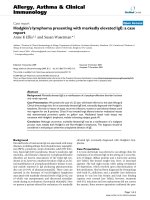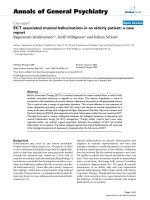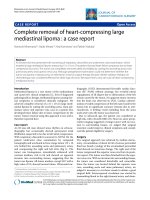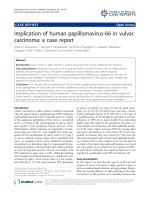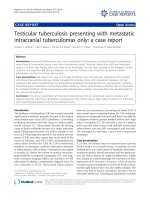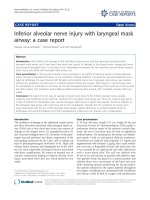Báo cáo y học: "Cardiac arrest provoked by itraconazole and amiodarone interaction: a case report" ppt
Bạn đang xem bản rút gọn của tài liệu. Xem và tải ngay bản đầy đủ của tài liệu tại đây (275.88 KB, 5 trang )
CASE REP O R T Open Access
Cardiac arrest provoked by itraconazole and
amiodarone interaction: a case report
Angeliki M Tsimogianni
*
, Ilias Andrianakis, Alex Betrosian and Emmanouil Douzinas
Abstract
Introduction: Azoles, and specifically itraconazole, are often prescribed for the treatment of fungal diseases or
empirically for persistent sepsis in patients who are neutropenic or in intensive care. Occasional cardiovascular
adverse events have been associated with itraconazole use, and are usually attributed to the interaction of
itraconazole with cisapride, terfenadine or digoxin. Its interaction with amiodarone has not been previously
described.
Case presentation: A 65-year-old Caucasian man was admitted to the Intensive Care Unit at our facility for an
extensive ischemic stroke associ ated with atrial fibrillation. Due to rapid ventricular response he was started on
intravenous amiodarone and few days later itraconazole was also prescribed for presumed candidemia. After
receiving the first dose our patient became profoundly hypotensive but responded rapidly to fluids and adrenaline.
Then, two months later, itraconazole was again prescribed for confirmed fungemia. After receiving the first dose
via a central venous catheter our patient became hypotensive and subsequently arrested. He was resuscitated
successfully, and as no other cause was identified the arrest was attributed to septic shock and his antifungal
treatment was changed to caspofungin. When sensitivity test results became available, antifungal treatment was
down-staged to itraconazole and immediately after drug administration our patient suffered another arrest and
was once again resuscitated successfully. This time the arrest was related to itraconazole, which was discontinued,
and from then on our patient remained stable until hi s discharge to our neurology ward.
Conclusions: Itraconazole and amiodarone coadministration can lead to serious cardiovascular adverse events in
patients who are critically ill. Intensivists, pharmacists and medical physicians should be aware of the interaction of
these two commonly used drugs.
Introduction
Itraconazole has been widely used in the treatment of
fungal diseases including chronic necrotizing pulmonary
aspergillosis [1]. Patients in intensive care units with
persistent high temperature despite broad-spectrum
antibiotic trea tment should be considered for empirical
antifun gal treatment due to the high incidence of candi-
demia and high mortality ra tes reported [2]. Azoles, flu-
conazole and itrac onazole are the most justified options
in this situation [3]. Itraconazole use has been associated
with occasional adver se card iovascular events, including
congestive heart failure [4], hypertension, premature
ventricular contractions or other dysrhythmias [5,6], and
ventricular fibrillation [7]. These adverse events have
been considered uncommon and are most often attribu-
ted to interaction of itraconazole with cisapride, terfena-
dine or digoxin [8].
In this study, we describe the case of a patient with
ischemic stroke who had one hypotensive episode and
two cardiac arrests after administration of intravenous
itraconazole. To the best of our knowledge this is the
first case reported o f cardiac arrest due to inte raction of
itraconazole and amiodarone.
Case report
A 65-year-old Caucasian man with history o f hyperten-
sion was admitted to our neurology department with
sudden loss of consciousness associated with right-sided
hemiplegia. An electrocardiogram (ECG) showed atrial
fibrillation (AF) with rapid ventricular response; his
echocardiogram ejection fraction of 60% with no wall
* Correspondence:
Third Intensive Care Department, Evgenidion Hospital, 20
Papadiamantopoulou Street, 11528, Athens, Greece
Tsimogianni et al. Journal of Medical Case Reports 2011, 5:333
/>JOURNAL OF MEDICAL
CASE REPORTS
© 2011 Tsimogianni et al; licensee BioMed Central Ltd. This is an Open Access article di stributed under the terms of the Creative
Commons Attribution License ( s/by/2.0), which permits unrestricted use, distribution, and
reproduction in any medium, provided the original work is properly cited.
hypokinesia and computed tomography (CT) results
confirmed i schemic changes in the area of distribution
of the left anterior cerebral artery. He was started on
intravenous amiodarone (Angoron; Sanofi Aventis) for
rate control. Over the next few hours our pa tient’s level
of consciousness deteriorated and he required intubation
and transfer to our intensive care unit. A few days later,
he developed septic shock complicated with acute renal
failure, and in addition to broad-spectrum antibiotic
treatment empirical antifungal treatment with itracona-
zole (Micronazole; Pharma Line) was also prescribed.
Soon after administration of the first dose our patient
became profoundly hypotensive (blood pressure 50/30
mmHg) without obvious ECG changes. He responded to
fluids, bolus and adrenaline infusion and within a couple
of hours vasoactive drugs were discontinued. This hypo-
tensive episode was considered septic, as no other
apparent cause was identified.
Over the next few days, while our patient was stabi-
lized and his renal function improved he developed ani-
socoria due to a new ischemic stroke on the opposite
side, complicated with brain edema. He was treated con-
servatively and his level of consciousness progressiv ely
improved; he was weaned off the ventilator but due to
thepresenceofatracheotomyandintermittentseptic
episodes his stay in the intensive care unit was pro-
longed. Two months after his intensive care unit admis-
sion, fungi were isolated on blood cultures and our
patient was started on i traconazole treatment, awaiting
sensitivity test results. At that point, he had a high tem-
perature but was breathing spontaneously and was
hemodynamically stable. He was also receiving oral
amiodarone 200 mg/day. After receiving the first dose of
200 mg itraconazole through a cen tral venous catheter,
our patient’ s blood pressure dropped suddenly from
150/90 mmHg to 50/30 mmHg and he subsequently
lost consciousness and output; his ECG was compatible
with pulsele ss electrical activity, with a rate of approxi-
mately 55 beats/minute. Our patient was connected to
the ventilator again, cardiac massage was performed for
three minutes and 2 mg of adrenaline was administered
until the return of spontaneous circulation. Subse-
quently, noradrenaline infusion at a rate of 150 μg/min-
ute was star ted, a d ose that was progressively reduced
and discontinued. His arterial blood gases, electrolytes
and troponin immediately after resuscitation are shown
in Table 1. His ECG after the arrest showed atrial fibril-
lation (AF), 100 bpm with prolonged co rrected QT
interval, with no o ther changes. A few hours later his
QT interval returned to normal. Our patient’s level of
consciousness did not show any deterioration and
results of a follow-up brain CT scan were slightly
improved compared to the results of the previous scan.
This episode was eventually attributed to sepsis from
fungemia and the antifungal treatment was changed to
caspofungin 50 m g (Cancidas; Merck) awaiting sensitiv-
ity test results. All medications administered to our
patient on the day of the arrest are presented in
Table 2. Five days later, our patient’ sbloodculture
results became available. Candida parapsilosis was iso-
lated, sensitive to fluconazole and itraconazole, and anti-
fungal treatment was down-staged to itraconazole. Due
to an u ncontrolled heart rate he also received a 300 mg
of bolus amiodarone. A few minutes after receiving the
itraconazole (200 mg) he suffered another pulseless elec-
trical activity arrest; this time cardiac massage was per-
formed for 10 minutes, and bolus adrenaline and
atropine were administered until he was resuscitated
successfully. His arterial blood gases, electrolytes and
troponin immediately and six hours after resuscitation
were again unremarkable. This time it became clear that
itraconazole was related to the arrests and was discon-
tinued. F rom then on, our patient remained stable and
15 days later was discharged back to our neurology
ward.
Discussion
We present the case of a 65-year-old man with ischemic
stroke who collapsed once and arrested twice after itra-
conazole infusion through a central venous catheter
while receiving amiodarone for AF. The first and second
time, the episodes were attributed to sepsis and that is
Table 1 Routine tests after arrest
Test and parameters Settings
Ventilator settings:
Mode Pressure regulated volume control
Tidal volume 600 mL
Frequency 18 breaths/minute
Positive end-
expiratory pressure
5 mmHg
FiO
2
100%
Arterial blood gases:
PaO
2
448 mmHg
PaCO
2
15 mmHg
pH 7.37
HCO
3
10 mm/L
Electrolytes:
Na 142 mm/L
K 4.7 mmol/L
Lactate 5.7 mmol/L
Hematocrit 26.3%
Troponin <0.05 ng/mL
Electrocardiogram Atrial fibrillation, prolonged corrected QT
interval, no ischemic changes
Pa = partial pressure.
Tsimogianni et al. Journal of Medical Case Reports 2011, 5:333
/>Page 2 of 5
why the medication was administered a third time. Our
patient was resusci tated rapidly after these episodes and
all alternative causes for the arrests were excluded. Our
patient was followed up for 15 days after the last epi-
sode, was stable, and was eventually discharged back to
our neurology ward. According to the Naranjo scale [9]
this adverse r eaction is graded as 9, which makes the
association of itraconazole with the arrest definite
(Table 3). A challenge test was not performed for ethical
reasons.
In the literature [4-7], itraconazole use has been
associated with occasional advers e cardiovascular events
including congestive heart failure, hypertension and
various dysrhythmias, most often in patients with pre-
existingcardiacdisease[6].Theseadverseeventshave
been co nsidered uncommon and most times attributed
to interaction of itraconazole with cisapride, terfenadine,
digoxin or methadone [8]. The possibl e mechanisms for
these adverse events are the negative inotropic effect of
itraconazole per se and the prolongation of the QT
Table 2 List of medications taken by our patient the day of the first cardiac arrest
Medication Dose Route of administration
Meropenem (Meronem) 1 g × 3 Intravenously
Human albumin 25% (Plasbumin) 50 mL × 2 Intravenously
Furosemide (Lasix) 20 mg × 2 Intravenously
Tigecycline (Tygacil) 50 mg × 2 Intravenously
Iron (Anemifer) 100 mg × 1 Intravenously
Pantoprazole (Pantosec) 40 mg × 2 Intravenously
Fondaparinux sodium (Arixtra) 2.5 mg × 1 Subcutaneously
Epoetin zeta (Retacrit) 40,000 IU
†
once weekly Subcutaneously
Amiodarone (Angoron) 200 mg × 1 Levin
Saccharomyces boulardii (Ultra Levure) Two caps × 3 Levin
Table 3 Naranjo scale
Questionnaire question and answer scoring Answer/score
1. Are there previous conclusive reports on this reaction? No (0)
Yes (+1); no (0); do not know or not done (0)
2. Did the adverse event appear after the suspected drug was given? Yes (+2)
Yes (+2); no (-1); do not know or not done (0)
3. Did the adverse reaction improve when the drug was discontinued or a specific antagonist was given? Yes (+1)
Yes (+1); no (0); do not know or not done (0)
4. Did the adverse reaction appear when the drug was readministered? Yes (+2)
Yes (+2); no (-2); do not know or not done (0)
5. Are there alternative causes that could have caused the reaction? No (+2)
Yes (-1); no (+2); do not know or not done (0)
6. Did the reaction reappear when a placebo was given? No (+1)
Yes (-1); no (+1); do not know or not done (0)
7. Was the drug detected in any body fluid in toxic concentrations? No (0)
Yes (+1); no (0); do not know or not done (0)
8. Was the reaction more severe when the dose was increased, or less severe when the dose was decreased? Yes (+1)
Yes (+1); no (0); do not know or not done (0)
9. Did the patient have a similar reaction to the same or similar drugs in any previous exposure? No (0)
Yes (+1); no (0); do not know or not done (0)
10. Was the adverse event confirmed by any objective evidence? No (0)
Yes (+1); no (0); do not know or not done (0)
Scoring:
>9 = definite adverse drug reaction (ADR), 5-8 = probable ADR, 1-4 = possible ADR, 0 = doubtful ADR 9 = definite ADR
Tsimogianni et al. Journal of Medical Case Reports 2011, 5:333
/>Page 3 of 5
interval leading occasionally to torsades de pointes, as
itraconazole may increase plasma levels of the above
medications (which prolong the QT interval). The rapid
intravenous administration, insufficient dilution and
drug vehicle have been associated with the dysrhythmias
caused by imidazole antifungals. Our patient was conco-
mitantly receiving amiodarone, the first and third time
intravenously and the second time orally, which can
prolong the QT interval but his ECG in the intensive
care unit was monitored continuously and torsades de
pointes did not occur. During both arrests his ECGs
were compatible with pulseless electrical activity, slightly
bradycardic and the first event that occurred was the
sudden drop in blood pressure. Another explanation
could be an anaphylactic-type reaction causing vasodila-
tionandshock.Webelievethemostlikelyexplanation
for the arrests is the direct myocardial depression of the
drug per se in combination with the negative inotropic
[7] and chronotropic effect of amiodarone, enhanced by
its increased plasma levels as a result of its reduced liver
metabolism caused by itraconazole. Regardless, the rapid
infusion though a central venous catheter and the inter-
action with amiodarone seems to have contributed to
the arrest.
Making an appraisal of our patient management, we
could first criticize that intravenous itraconazole was
prescribed to our patient while he was on hemodiafil-
tration and had a creatinine clearance below 30 mL/
minute. In the medical information for the drug, it is
suggested the oral formulation be used for a creati-
nine clearance lower than 30 mL/minute due to pos-
sible accumulation of cyclodextrin. In our defense
this is common practice in intensive care units; intra-
venous formulations are always preferred due to
impaired absorption of drugs from the gastrointest-
inal tract in patients who are critically ill. Moreover,
other medical sources only suggest halving the dose
[10] for clearance <10 mL/minute. In subsequent
administrations of the medication our patient’sclear-
ance was above 50 mL/minute. Finally, imidazole
agents are the preferred treatment choices for the
empirical treatment of fungal infections in intensive
care units [2].
The limitations of our case report are first of all the
difficulty in confirming the association of the drug with
the arrest by a n objective measurement. In our defense,
this is common in adverse drug reactions, the associa-
tion with a specific drug can be assessed with the Nar-
anjo scale and according to this scale the cardiac arrest
after itraconazole infusion was a definite adverse drug
reaction [9]. More importantly, the mechanism of the
arrest is not fully understood. F urther studies are
required to investigate the cardiologic side effects of
itraconazole and the possible interacti on of i traconazole
and amiodarone, a commonly used antiarrhythmic drug
in intensive care units.
Conclusions
In this article, we present the case of a patient who had
one hypotensive episode and two cardiac arrests after
concomitant administration of itraconazole and amio-
darone. To the best of our knowledge this considerable
side effect has not been described in the literature p re-
viously. Intensivists, pharmacists and medical physicians
of various specialties such as cardiologists, oncologists
and hematologists, should be aware of this possible
interaction with deleterious results. Patients receiving
medications that can prolong the QT interval or with
pre-existing cardiac disease should be administered the
intravenous formulation of this medication with caution,
especially if given through a central venous catheter.
Consent
Written informed consent was obtained from the
patient’s next-of-kin for publication of this case report
and any accompanying images. A copy of the written
consent is available for review by the Editor-in-Chief of
this journal.
Acknowledgements
We would like to thank all the nursing staff and on call doctors for their
contribution to our patient’s management and acquisition of all relevant
data.
Authors’ contributions
AMT resuscitated our patient from both arrests, identified the association of
the arrest with the drug, had a significant contribution in acquisition and
interpretation of patient data, a major role in drafting the manuscript and
read and approved the final manuscript. IA had a leading role in drafting
and revising the manuscript and has read and approved the version to be
published. AB had the initial concept of presenting this case report,
contributed significantly to the interpretation of our patient’s data and
revision of the manuscript, and read and approved the version of the
manuscript to be published. ED read and approved the final version of the
manuscript.
Competing interests
The authors declare that they have no competing interests.
Received: 14 September 2010 Accepted: 29 July 2011
Published: 29 July 2011
References
1. Saraceno JL, Phelps DT, Ferro TJ, Futerfas R, Schwartz DB: Chronic
necrotizing pulmonary aspergilosis: approach to management. Chest
1997, 112:541-548.
2. Rüping MJ, Vehreschild JJ, Cornely OA: Patients at high risk of invasive
fungal infections: when and how to treat. Drugs 2008, 68:1941-1962.
3. Guinea J, Peláez T, Rodríguez-Créixems M, Torres-Narbona M, Muñoz P,
Alcalá L, Bouza E: Empirical treatment of candidemia in intensive care
units: fluconazole or broad-spectrum antifungal agents? Med Mycol 2009,
47:515-520.
4. Ahmad SR, Singer SJ, Leissa BG: Congestive heart failure associated with
itraconazole. Lancet 2001, 357:1766-1767.
5. Okamoto J, Fukunami M, Kioka H: Frequent premature ventricular
contractions induced by itraconazole. Circ J 2007, 71:1323-1325.
Tsimogianni et al. Journal of Medical Case Reports 2011, 5:333
/>Page 4 of 5
6. Fung SL, Chau CH, Yew WW: Cardiovascular adverse effects during
itraconazole therapy. Eur Respir J 2008, 32:240.
7. Nelson MR, Smith D, Erskine D, Gazzard BG: Ventricular fibrillation
secondary to itraconazole induced hypokalaemia. J Infect 1993, 26:348.
8. McClean KL, Sheehan GJ: Interaction between itraconazole and digoxin.
Clin Infect Dis 1994, 18:259-260.
9. Naranjo CA, Busto U, Sellers EM, Sandor P, Ruiz I, Roberts EA, Janecek E,
Domecq C, Greenblatt DJ: A method for estimating the probability of
adverse drug reactions. Clin Pharmacol Ther 1981, 30:239-245.
10. Merck Sharp & Dohme Corp: Itraconazole drug information.[http://merck.
com/mmpe/lexicomp/itraconazole.html].
doi:10.1186/1752-1947-5-333
Cite this article as: Tsimogianni et al.: Cardiac arrest provoked by
itraconazole and amiodarone interaction: a case report. Journal of
Medical Case Reports 2011 5:333.
Submit your next manuscript to BioMed Central
and take full advantage of:
• Convenient online submission
• Thorough peer review
• No space constraints or color figure charges
• Immediate publication on acceptance
• Inclusion in PubMed, CAS, Scopus and Google Scholar
• Research which is freely available for redistribution
Submit your manuscript at
www.biomedcentral.com/submit
Tsimogianni et al. Journal of Medical Case Reports 2011, 5:333
/>Page 5 of 5
